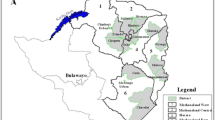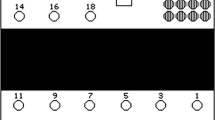Abstract
The acquisition efficiency of Tomato spotted wilt virus (TSWV) by Frankliniella occidentalis was examined using TSWV-infected Datura stramonium with various virus titres. TSWV quantities in leaves were measured using double antibody sandwich enzyme-linked immunosorbent assay (DAS-ELISA) and quantitative reverse transcription-polymerase chain reaction (qRT-PCR). The percentages of viruliferous F. occidentalis significantly correlated with DAS-ELISA and qRT-PCR values in the fed leaf piece. The detectable period of TSWV in viruliferous F. occidentalis adults trapped on sticky traps was also examined at various temperatures. At 25°C or less, TSWV could still be detected by DAS-ELISA in the bodies for at least 20 days after the capture of viruliferous F. occidentalis, although ELISA values had decreased gradually over time more rapidly at higher temperatures. The quantities of TSWV RNA detected by qRT-PCR rapidly decreased. The mean value decreased to half in a day, and reduced to 7.3% of the initial mean value after 14 days.





Similar content being viewed by others
References
Boissot N, Reynaud B, Letourmy P (1998) Temporal analysis of western flower thrips (Thysanoptera: Thripidae) population dynamics on Reunion Island. Environ Entomol 27:1437–1443
Cho JJ, Mau RFL, Hamasaki RT, Gonsalves D (1988) Detection of tomato spotted wilt virus in individual thrips by enzyme-linked immunosorbent assay. Phytopathology 78:1348–1352
Culbreath AK, Todd JW, Brown SL (2003) Epidemiology and management of tomato spotted wilt in peanut. Annu Rev Phytopathol 41:53–75
De Assis Filho FM, Deom CM, Sherwood JL (2004) Acquisition of Tomato spotted wilt virus by adults of two thrips species. Phytopathology 94:333–336
Fukumoto F, Tochihara H (1981) Effect of various additives on long-term preservation of tomato spotted wilt virus. Ann Phytopathol Soc Japan 47:688–690 [in Japanese with English figure captions]
Moritz G, Kumm S, Mound L (2004) Tospovirus transmission depends on thrips ontogeny. Virus Res 100:143–149
Nagata T, Inoue-Nagata AK, Smid HM, Goldbach R, Peters D (1999) Tissue tropism related to vector competence of Frankliniella occidentalis for tomato spotted wilt tospovirus. J Gen Virol 80:507–515
Okazaki S, Okuda M, Komi K, Yoshimatsu H, Iwanami T (2007) Overwintering viruliferous Frankliniella occidentalis (Thysanoptera: Thripidae) as an infection source of Tomato spotted wilt virus in green pepper fields. Plant Dis 91:842–846
Pappu HR, Jones RAC, Jain RK (2009) Global status of tospovirus epidemics in diverse cropping systems: successes achieved and challenges ahead. Virus Res 141:219–236
Riley DG, Pappu HR (2004) Tactics for management of thrips (Thysanoptera: Thripidae) and tomato spotted wilt virus in tomato. J Econ Entomol 97:1648–1658
Rochow WF, Blizzard JW, Muller I, Waterworth HE (1976) Storage of preparations of barley yellow dwarf virus. Phytopathology 66:534–536
Sakurai T (2006) Optimum number of repetitions of petunia leaf disk assay for detecting adult Frankliniella occidentalis that transmits Tomato spotted wilt virus. Ann Rept Plant Prot North Japan 57:185–187 [in Japanese with Emglish abstract]
Tsuda S, Fujisawa I, Hanada K, Hidaka S, Higo KI, Kameya-Iwaki M, Tomaru K (1994) Detection of tomato spotted wilt virus S RNA in individual thrips by reverse transcription and polymerase chain reaction. Ann Phytopathol Soc Japan 60:99–103
Ullman DE, Cho JJ, Mau RFL, Westcot DM, Custer DM (1992) A midgut barrier to tomato spotted wilt virus acquisition by adult western flower thrips. Phytopathology 82:1333–1342
Ullman DE, Sherwood JL, German TL (1997) Thrips as vectors of plant pathogens. In: Lewis TL (ed) Thrips as crop pests. CAB International, New York, pp 539–565
Van de Wetering F, Goldbach R, Peters D (1996) Tomato spotted wilt tospovirus ingestion by first instar larvae of Frankliniella occidentalis is a prerequisite for transmission. Phytopathology 86:900–905
Whitfield AE, Ullman DE, German TL (2005) Tospovirus-thrips interactions. Annu Rev Phytopathol 43:459–489
Wijkamp I, Peters D (1993) Determination of the median latent period of two tospoviruses in Frankliniella occidentalis, using a novel leaf disk assay. Phytopathology 83:986–991
Wijkamp I, Almarza N, Goldbach R, Peters D (1995) Distinct levels of specificity in thrips transmission of tospoviruses. Phytopathology 85:1069–1074
Yudin LS, Mitchell WC, Cho JJ (1987) Color preference of thrips (Thysanoptera: Thripidae) with reference to aphids (Homoptera: Aphididae) and leafminers in Hawaiian lettuce farms. J Econ Entomol 80:51–55
Zen S, Okuda M, Fuji S, Iwanami T (2008) The seasonal occurrence of viruliferous Thrips tabaci and the incidence of Iris yellow spot virus disease on lisianthus. J Plant Pathol 90:511–515
Acknowledgements
We thank Dr. Hanu R. Pappu, Washington State University, for his helpful suggestions for the manuscript. We thank Dr. Toshiro Kawano, Research Institute of Japan Plant Protection, for providing purified TSWV nucleocapsids.
Author information
Authors and Affiliations
Corresponding author
Rights and permissions
About this article
Cite this article
Okazaki, S., Okuda, M., Komi, K. et al. The effect of virus titre on acquisition efficiency of Tomato spotted wilt virus by Frankliniella occidentalis and the effect of temperature on detectable period of the virus in dead bodies. Australasian Plant Pathol. 40, 120–125 (2011). https://doi.org/10.1007/s13313-010-0020-z
Received:
Accepted:
Published:
Issue Date:
DOI: https://doi.org/10.1007/s13313-010-0020-z




